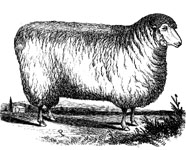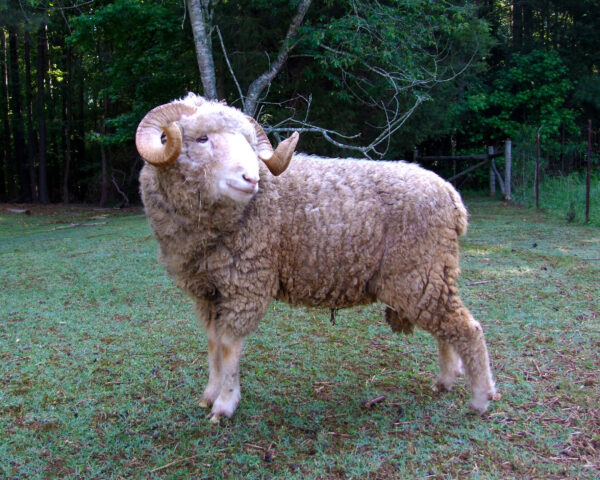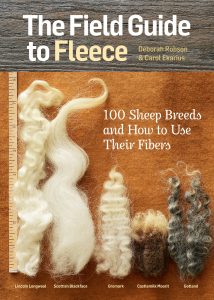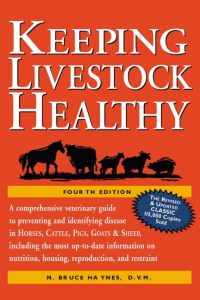
Breed Facts
Status:
Threatened
Use:
Meat, Wool, Milk
Adult Weight:
Rams: 225-275 lbs. Ewes: 150-200 lbs.
Temperament:
Docile
Experience Level:
Novice – Intermediate
Notes:
Aseasonal breeders; good feed conversion; can raise two sets of lambs a year
DORSET HORN SHEEP
The Dorset is an ancient breed likely developed from white-faced, horned, short wooled sheep that thrived in the sheltered valleys and lush hill pastures of southwestern England. Today, the Dorset is globally distributed and found in two varieties, Horned and Polled. The Dorset Horn, or Horned Dorset, is of conservation interest.
Dorset Horn sheep were first imported into the US about 1860, although the breed didn’t appear in large numbers until the 1880s. The Continental Dorset Club was organized in 1890. In the early 1950s, a genetic mutation causing polledness appeared in four lambs at North Carolina State University in Raleigh, North Carolina, and the Polled Dorset variety was developed there. (Polled Dorsets were also created in Australia earlier in the 1900s through the introduction of Corriedale and Ryeland blood into the Dorset Horn.)
The Continental Dorset Club registered the first Polled Dorsets in 1956, and they have been included in the same flock book with Dorset Horns. The success of the polled variety has caused the Dorset to become the second most popular sheep breed in the United States. Polled Dorset sheep have almost completely eclipsed Dorset Horns, and the latter is experiencing a precipitous drop in registrations. The Polled Dorset and Dorset Horn have diverged somewhat over the past 40 years. Though differences between the populations have not been documented, anecdotal evidence suggests that the intensive selection for early maturation and rapid growth rate in Polled Dorsets may have been made at the expense of selection for nonseasonal breeding, which has declined as a result. Given the possible impact of these changes and the long divergence of American Dorset Horn sheep from other Dorset populations, the Dorset Horn has been included as a conservation priority.
Dorsets are white sheep with open faces and long bodies. Ewes weigh 150-200 lbs., and rams weigh 225-275 lbs. Both ewes and rams have horns. Ewes’ horns are light, curving forward neatly; rams’ horns are heavy and spiral out and curve forward. The sheep are avid grazers and have good feed conversion. Ewes are heavy milkers and can easily raise their own lambs. They have also been used in dairying and for the production of cheese. Dorset sheep produce between five and nine pounds of medium-grade wool per year.
The single most important attribute of the Dorset is its extended breeding season, also called nonseasonal or aseasonal breeding. This characteristic, not found in any other British breed, is an important performance trait. Sheep of most breeds are seasonal breeders, mating in the fall and producing lambs in the spring. In contrast, Dorsets can be bred in the spring to produce lambs in the fall. Some ewes will raise two sets of lambs a year, with multiple births not uncommon. Dorsets tolerate heat well, and heat tolerance contributes to Dorset rams’ ability to breed earlier in the season than rams of other breeds.
They are calm and docile and can make good pets, although rams should be handled when they are young so they are easier to manage during the breeding season. They have also been used to train herding dogs. Dorset Horn sheep are good foragers.
Did you know:
The Conservation Priority List is organized historically. Breeds originating in North America are listed first, followed by those imported before 1900 and those that came
to our shores later. Many of these breeds were founded in the United States. That means we have a special responsibility for their conservation. You can invest in living history for as little as $4 per month. Click here to become a Conservation Champion today!
You may be interested in…

Breed Facts
Status:
Threatened
Use:
Dual
Adult Weight:
160 – 200 lbs
Temperament:
Docile
Experience Level:
Novice – Intermediate
Notes:
A-seasonal breeders
You may be interested in…




